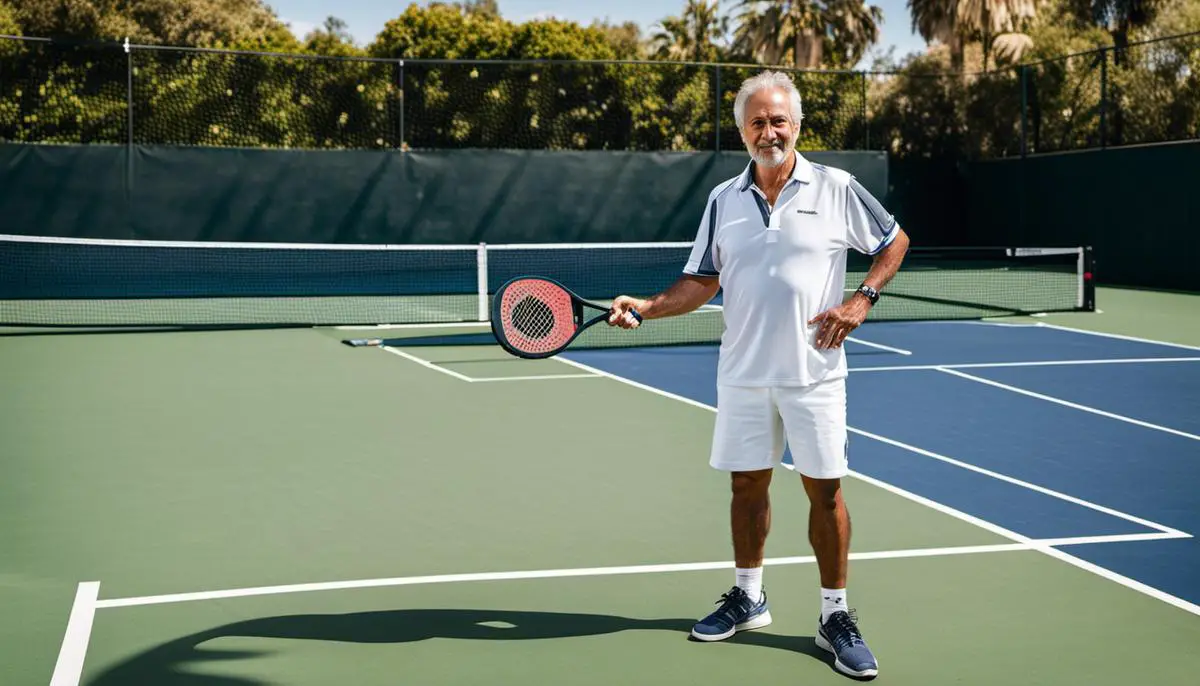Enrique Corcuera, a visionary whose talent stretched beyond the confines of a tennis court, embarked on an endeavor that would change the landscape of racket sports worldwide. Born and raised in the rural tranquility of Mexico, Corcuera was far from shy of embracing his innate knack for innovation. His passion for sports, sharp intellect, and open-minded approach to life acted as a cradle for the inception of Padel- a game that would eventually become globally recognized, introducing a unique amalgamation of skill and strategy for sports enthusiasts. This exploration of Enrique’s journey, from a humble background to finding a place in the annals of sports history, delves into the life of a man who dared to dream and brought Padel into existence.
Early Life of Enrique Corcuera
Early Years of Enrique Corcuera
Enrique Corcuera was born on June 12, 1934, in a family with a deep passion for sports. Growing up in Mexico City, Corcuera was exposed to the world of sports at an early age. His father was a well-known tennis player, introducing Corcuera to one of his lifetime hobbies.
Enrique Corcuera attended prestigious schools in Mexico City, where he was encouraged to prioritize both sports and academics. Since his formative years, Corcuera demonstrated an innovative mindset, frequently altering the rules of regular playground games. His love for sports transcended the playground and into his studies, often engaging in school sports clubs and competitions.
The signs of his pioneering mindset were evident when he invented a new game at his home in Acapulco. He inherited a rich tradition of tennis, but there was not enough space at his new house for a full-sized court. Not being deterred by this physical limitation, Corcuera instead adapted the game layout to fit the space available, resulting in a smaller playing field. Thus, the idea of Padel was conceived.
During Corcuera’s time in college, he focused on broadening his knowledge and developing an innovative mindset. He was always striving for solutions to problems, whether they were of an intellectual or physical nature.
Learning architecture and later working as a successful entrepreneur, Corcuera’s profession kept fueling his experimental mindset that drove him towards the discovery of Padel. Though he was no longer a professional athlete, Corcuera went on to contribute significantly to the sports world with the invention of Padel. He wasn’t just an innovator in his professional field, but he brought innovation into his passion for sports as he set the stage for a new era of racket sports.
Padel’s Historical Development
Enrique Corcuera, a visionary and sports enthusiast, conceived the idea of Padel in 1969. His innovative concept, interestingly, merged tennis and squash into a game suitable for all age groups and fitness levels. Players would play the game on a smaller, enclosed court using a solid ball and racket without strings, making it an approachable and interesting variation of traditional tennis.
Corcuera’s ingenuity combined with his passion for sports and knack for solving problems led to the invention of this unique game. Padel, originally created for his own enjoyment, rapidly gained popularity in Mexico and spread across the globe. The rapid emergence of courts in Spain, Argentina, and other countries concretely established Padel In the world of sports, making it one of the most rapidly expanding games worldwide.
Corcuera, the pioneer of Padel, will forever remain an influential figure in the realm of sports due to his creative prowess and contributions. His unique background, schooling, and early life experiences served as the catalyst for his ground-breaking idea of this adaptable racquet sport. His enduring love for sports wasn’t just a hobby, but developed into the creation of a globally recognized sport, leaving a significant impact on the sporting world.

Invention of Padel
The Man Behind Padel: Enrique Corcuera
Enrique Corcuera, a highly regarded Mexican industrialist and keen tennis enthusiast, embarked on the path of inventing Padel in the late 1960s. His expansive residence in Acapulco provided the perfect location for playing tennis. However, owing to the space limitations of his estate, the construction of a standard size tennis court proved to be a formidable challenge.
Pioneering Padel: An Idea Rooted in Innovation
Rather than capitulating to these spatial constraints, Corcuera decided to devise a unique solution that subsequently gave birth to the game of Padel. By necessity, he designed a court that was much smaller than a conventional tennis court, utilizing the walls surrounding the court as part of the game, akin to squash. To accommodate for the altered playfield, Corcuera also modified the traditional tennis racket, opting for a simplified, string-less perforated paddle, hence the name ‘Padel.’
Overcoming Challenges and Establishing the First Padel Court
Building the first-ever Padel court proved to be a challenging task. The modified court dimensions and inclusion of peripheral walls drastically changed the dynamics of the game, requiring players to develop new strategies and techniques to compensate. Corcuera’s original Padel court measured 20 by 10 meters, enclosed by walls on all sides. The walls on both ends were 4 meters high, whereas the side walls started at a height of 3 meters near the net, reducing to 2 meters towards the baseline.
Corcuera faced difficulties not only in the design and construction phases but also in promoting this new game. He had to confront skepticism and resistance from traditionalists who were reluctant to accept this innovative form of tennis. It required immense perseverance and patience on Corcuera’s part to gradually familiarize people with Padel and garner its initial set of followers.
Fine-tuning Padel: Adjustments and Improvements
Padel continued to evolve under Corcuera’s attentive oversight. He maintained the smaller court size, which had been initially determined by his estate’s space constraints, even after Padel started gaining popularity. As Corcuera fine-tuned the rules, he decided to keep the sport more accessible and less physically demanding than tennis, emphasizing strategy and accuracy over power. He also standardized the paddle design, maintaining its solid, string-less construction.
Enrique Corcuera, the inventor of Padel, has left an indelible mark on the world of sports. Despite facing a myriad of challenges, he succeeded in creating a sport that cleverly blends elements of tennis and squash. Originally sparked by limitations, Padel’s inception serves as a powerful testament to Corcuera’s imaginative ingenuity and unrelenting dedication.

Spread and Popularity of Padel
Unveiling Enrique Corcuera: The Padel Pioneer
Enrique Corcuera was not just a Mexican businessman but also a passionate sports enthusiast, widely acknowledged as the initiator of the paddle sport we now know as Padel. His beachside residence in Acapulco, Mexico, is the cradle of Padel, brought to life in 1969. Corcuera encountered unique challenges given the unconventional terrain of his property, forcing him to design a more compact tennis court surrounded by walls. It was out of this constrained ingenuity, that the distinctive game of Padel took flight.
Initial Spread of Padel
Corcuera shared this new game with a friend, Prince Alfonso of Hohenlohe, who was immediately captivated. The prince, a Spanish entrepreneur widely known for his initiatives in Marbella’s development, brought Padel back to Spain. In Marbella, he built the first known Padel Club in 1974 at his own Marbella Club Hotel. The game quickly spread among the wealthy elite and became a popular sport in Spain.
Globalization and Achievements
From Spain, Padel began to spread abroad and became particularly popular in Spanish-speaking countries. By the 1990s, it was introduced to Argentina, which today houses the most Padel players worldwide. The sport continued its expansion into Europe, predominantly in Italy, Sweden, and the UK, followed by several other nations like Portugal, Belgium, and France.
Enrique Corcuera’s invention led to milestones such as the creation of the Spanish Padel Federation in 1991, which led to the sport’s inclusion in the Spanish Sports Council in 1995. In turn, the International Padel Federation was formed in 1991 to promote and consolidate the sport worldwide.
Enrique Corcuera’s Continuing Influence
Although Mexico can’t compete with Argentina and Spain’s Padel fanatics, Enrique Corcuera’s legacy continues to impact the sport. His inventive way to use the walls around the court set the game apart from other racquet sports. The game innovatively mixes skill components from sports like tennis and squash, bringing a unique blend of fun and intensity.
Padel: A Modern Global Sport
The International Padel Federation consistently organizes various championships across the globe, making Padel a loved sport, cutting across language barriers. The ongoing endeavors to incorporate Padel in the Olympic Games further underline its growing popularity and global reach.
The rapid global dissemination of Padel is largely credited to Enrique Corcuera, a Mexican businessman who devised a simple solution to utilize his property’s landscape and unexpectedly created a sport revered by millions. The enduring impact of Corcuera’s legacy is reflected in the ascendant popularity of Padel, as it continues to gain traction in new regions worldwide.

Enrique Corcuera’s Legacy
Meet Enrique Corcuera: The Man Behind Padel
Enrique Corcuera, the man renowned as the founder of Padel, was born in 1934 in Mexico City. A passionate sports enthusiast, particularly tennis, he stumbled upon a quandary in 1962 when he found a pitch on his Acapulco property wasn’t large enough for a tennis court. Enrique ingeniously conceived the idea of “Padel”, an entirely new sport incorporating aspects of tennis, squash, and badminton, to utilize the space.
Having introduced his invention to Marbella, Spain, it garnered the interest and appreciations of his friend, Prince Alfonso Hohenlohe. Consequently, Padel swiftly spread throughout Spain and Latin America, prompting Corcuera to establish standardized rules in 1974.
Impact of Enrique Corcuera’s Invention
The birth of Padel was a game-changer in the sporting world. This sport took off, with its popularity rising rapidly across Latin America and Europe. As of today, Spain, Argentina, and Mexico are the leading countries where Padel is played, largely due to Enrique’s invention.
Padel is valued for its inclusivity. Unlike tennis, it requires less physical prowess and is easier to learn, thus making it a sport for all ages and abilities. Enrique’s invention opened a new horizon for sport lovers and created a sense of community among Padel players.
Awards and Honors
For his significant contributions to the world of sport, Enrique Corcuera has received several honors. The Euskadi Padel Federation awarded him in 1997 for his invention of Padel while the International Padel Federation acknowledged his contribution to Padel in the World Padel Championships held in Mexico in 2002.
In addition, Enrique was inducted into the Padel Hall of Fame by the Argentina Federation of Padel in 2010. This international recognition honors those who have made significant contributions to Padel.
Enrique Corcuera’s Legacy
Enrique Corcuera’s legacy continues to thrive as Padel grows in popularity around the world. The sport is now practiced in over 90 countries, with estimates of more than 10 million players globally. Enrique’s creative spirit lives on in Padel, inspiring countless sports enthusiasts.
He is celebrated for taking a small-scale, backyard invention and turning it into a globally recognized sport that brings joy to people across the world. Corcuera’s story is a testament to the power of innovation and proof that great ideas can come out of the simplest circumstances.
In the world of sport, Enrique Corcuera will be always remembered as the man who made a significant difference with his invention of Padel.

Enrique Corcuera, undeniably, left behind an indelible mark on the world of sports. His innovation- Padel, grew from a humble backyard idea to a phenomenon that swept across continents, adding a new layer to the fabric of racket sports. Enrique’s dedication, unwavering perseverance, and the ability to think outside the box were the main drivers behind the success of Padel. Even after his demise, Corcuera’s legacy continues to inspire, and his invention provides countless enthusiasts a platform to learn, play, and relish the footprints this visionary left behind. As the story of Enrique Corcuera unravels, it projects the portrait of a man who transcended conventional boundaries and revolutionized sports forever.